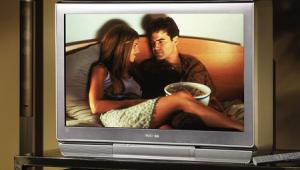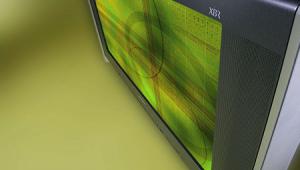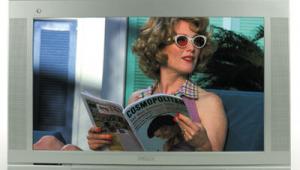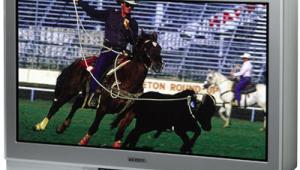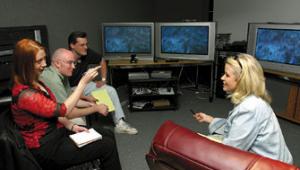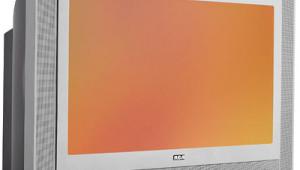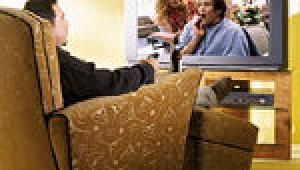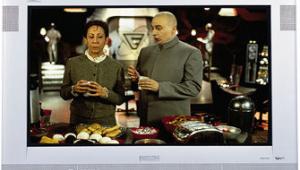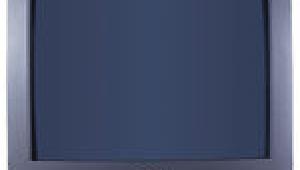Loewe Aconda Direct view 16:9 HDTV monitor
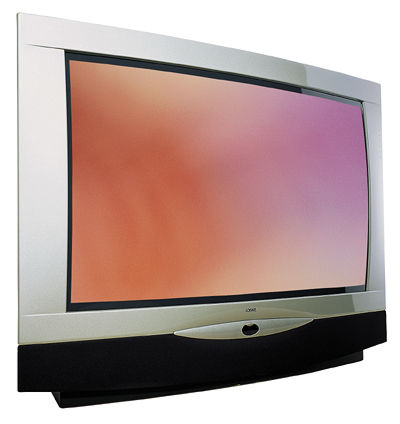
As you probably know, the FCC is trying to force the issue on the provider side of the equation, mandating deadlines for the transition. However, no one can mandate consumers to buy the more-expensive displays. As a result, manufacturers are trying to find ways to bring down the cost of DTV sets. One of the earliest solutions to this problem was to introduce digital monitors with no built-in ATSC (DTV/HDTV) tuner, which lowers the cost somewhat; also, buyers can use these sets as conventional TVs until they decide to add an outboard ATSC tuner. In fact, this approach is still being used by most manufacturers.
Among the many manufacturers of digital displays is Loewe Opta, a German company that has been making TVs since the 1930s. Their current DTV offerings include the Aconda 38-inch widescreen, direct-view monitor. Despite the fact that the Aconda has no ATSC tuner, it's one of the most expensive direct-view digital sets on the market. Does this mean it's a cut above the rest?
Looks
Like previous generations of Loewe direct-view DTVs, the Aconda cuts a clean, modern figure with a smooth, rounded, aesthetically pleasing shape. There are good handholds on the sides near the screen, but there are no handholds at the back of the set, which makes moving this 220-lb behemoth quite difficult. There's no getting around it: a glass picture tube of this size is heavy.
Speaking of the picture tube, it measures 38 inches diagonally, with a 16:9 aspect ratio and curved front surface. Surrounding the tube is a rather large frame; my review sample was finished in Piano Black, a high-gloss finish that's prone to reflections, which were somewhat distracting in anything other than a completely dark room. I suspect the Stratos Metallic case has a similar problem. If I were buying this set, I'd go for the Graphite Black model, which probably doesn't have this limitation (not to mention that it costs $500 less!).
On the front panel below the screen are several controls and connectors, including the master Power button, IR sensor, channel up/down buttons, Function button, headphone jack, and A/V inputs with S-video, composite video, and stereo audio. Two LEDs indicate when the set is in standby mode (red) or powered on (green).
The rear panel includes all other connections, including three main A/V inputs with S-video, composite-video, and stereo audio jacks. Unlike many other DTVs, the Aconda has only one component-video input, which is hardwired to Input 1. This is skimpy and inflexible; many people have at least two component sources (ATSC tuner and DVD player), but no component switching in their receiver or processor. With the Aconda, they must manually switch connections and reconfigure the TV's component input every time they want to switch from one to the other. This isn't a problem if you have an ATSC tuner with RGB output; alternatively, you can convert one device's component signal to RGB with an outboard transcoder.
Other rear-panel connections include two RF antenna/cable inputs, one RF loop output, a DB-15 VGA/RGB input, a VGA/RGB audio input, and an S/PDIF digital audio output. The selected input signal is sent to the monitor outputs, which include S-video and composite video as well as fixed and variable stereo audio. An external-speaker output lets you use external speakers instead of those in the set, and a subwoofer output can be connected to a Loewe subwoofer stand. Finally, an IR output passes remote commands to an IR blaster for controlling other devices, and a service input provides deeper access to the set's functions for a technician.
As far as I could tell, the remote hasn't changed from previous models. It's slim and well-designed, with significantly fewer buttons than most remotes I've used. In addition, the buttons are well-separated and organized so that it's easy to use in the dark after a short learning curve. (This is good—it isn't illuminated.)
With so few buttons on the remote, the menu system is the main avenue of control. Using a rather cumbersome hierarchical design, you navigate the menu system with the left/right/up/down ring on the remote, and execute commands with an OK button in the center. Each level of the hierarchy starts with a useless and annoying Welcome screen, which can thankfully be disabled. Some controls, such as Format (aspect ratio and stretch modes), are located deep within the menu system; fortunately, this particular parameter is also available directly from a button on the remote, as are the input-selector button and channel add/delete buttons. The menu system also includes an extensive Help section, which is, in fact, very helpful.
Guts
Among the Aconda's many features, the one that Loewe touts most highly is its internal scaler, which includes 3:2 pulldown that can be changed at two levels: Normal and Super. According to the company, the scaler performs true deinterlacing, rather than simply doubling the lines in each field, as some do. In addition to holding each field in a buffer and sending entire frames in the proper sequence, the scaler actually reconstructs all frames in conjunction with the digital motion-compensation circuit, which examines each pair of consecutive fields to select the picture information that will produce the sharpest image during fast motion. This also reduces judder, a type of jerkiness that is often evident in slow horizontal pans. The bottom line is smoother motion with fewer artifacts.
There are several aspect-ratio and stretch settings, including 16:9 (anamorphic) and 4:3 (in which the image appears in a 4:3 window with black bars on the sides of the screen). The zoom modes include: Panorama, which stretches a 4:3 image to fill the 16:9 screen; Cinema, which enlarges letterboxed movies to fill the screen; and Zoom, which enlarges images by the maximum amount. The stretch modes include digital line interpolation, which minimizes artifacts. While Cinema mode worked well with letterboxed material, including broadcast programs such as Enterprise and Babylon 5, I didn't use any of these modes to stretch standard program material; I prefer to see 4:3 images as the producers intended them.
Other features include digitally controlled scan-velocity modulation (which can be turned off in the service mode) and a digital comb filter for separating the chroma and luminance information in RF and composite signals. Digital Video Noise Reduction is designed to reduce the noise in poor-quality broadcast signals and video tapes, and Automatic Picture Control adjusts contrast and brightness levels according to the picture content. Being somewhat of a video purist, I generally don't engage these types of automatic controls, preferring to achieve the best picture I can manually and leave it at that.
The internal audio system is surprisingly good for being within a TV. The woofers are located in tuned chambers rather than venting directly into the TV cabinet, and several audio-enhancement circuits actually improved the sound; I especially liked the simulated 3D mode. I still recommend using an external 5.1-channel sound system with such a set, but it's nice to know that the internal sound system is more than an afterthought.
